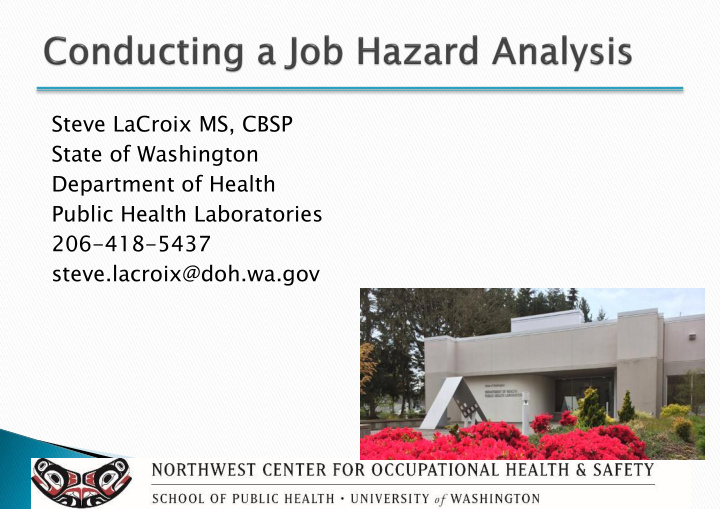



Steve LaCroix MS, CBSP State of Washington Department of Health Public Health Laboratories 206-418-5437 steve.lacroix@doh.wa.gov -1-
A job hazard analysis is a technique that focuses on the job tasks as a way to identify hazards before they occur. It focuses on the relationship between the worker, the task, the tools, and the work environment. After identifying uncontrolled hazards, take steps to eliminate or reduce them to an acceptable risk level. -2-
1. Identify hazards associated with each task (Job hazard analysis) 2. Assess hazard 3. Develop controls 4. Make risk based decisions 5. Implement controls 6. Supervise and evaluate -3-
Identify the activity or tasks to be evaluated. Break down the activity or task into distinct steps. Do not group too many steps into one. Identify the potential hazards for each of those steps. -4-
Indentify hazards associated with all job tasks and risk levels Utilized a predetermined process for hazard evaluation Summary table that can be easily understood. Compatible with existing safety protocols. Meets regulatory / accreditation requirements -5-
Assessment of hazards Assignment of risk levels Encompass work activities Sign off by those performing assessment Description of your assessment process -6-
Employee job classifications covered What activity / job are you covering Provide some background information Verbal summary of what found Convey information to employees? -7-
Summary table Resources utilized Management included and buy in Outline what did, maybe what didn’t do? -8-
Have “tools” available Checklists, BioRisk, APHL, ACS, SA, WHO, etc. Helps to trigger questions in the assessment process. Not static, evolving!!! -9-
-10-
Risk (assessment) is the probability of an adverse health effect as a result of exposure to hazards Communication is a fundamental part of risk assessment and training Effective risk management & safer workplaces -11-
Risk Group organisms Volume Aerosol production Clean up protocols Sharps / safer medical devices Training needs Past accidents / incidents? Emergency response adequate -12-
Waste handling Immunizations: Required / optional / documentation Occupational heath program Post exposure protocols Disinfectant Source of agent Infectious dose / pathogenicity / virulence / resistance / treatment / vaccines / -13-
Biosafety Level 1 – 4 Most are at Biosafety level 2 Biosafety Level 3 aerosol hazard but can treat Biosafety level 4 aerosol hazard and no treatment See BMBL, Biosafety in Microbiological and Biomedical Laboratories -14-
Risk Individual risk Community risk Group 1 no, low no, low 2 moderate low 3 high low 4 high high -15-
Hazard chemicals, Global Harmonization System, NFPA rating Carcinogens / teratogens / flammables explosives / toxins Chemical inventory correct Volume used / stored First Aid and spill control adequate -16-
Hazardous communication training up to date Specific training needed Storage and use appropriate PEL, STEL’s, etc. air monitoring needed? First aid materials / emergency response -17-
Low vs high level radiation handling Training adequate Receipt material screened Personnel exposure monitoring Equipment properly maintained and calibrated User vs work in area -18-
Slips, Trips & Falls Flying objects Electrical / Lock Out tag Out Fall protection Hearing, Hearing Conservation Program Ergonomics -19-
Biosafety cabinet Chemical fume hood Centrifuge bucket caps Cap removal blood tubes Building ventilation Levels of containment, i.e. plastic bags Specimens Category A packaging Safer medical devices -20-
-21-
Training Competency # employees performing duties How long perform duties / breaks Do you do it in the first place!!?? Is there a better way to do it?!! Spill clean up materials Operator manuals available / knowledgeable Hair tied back? Loose clothing Accident history -22-
After Administrative and Engineering controls implemented Institution have a basic clothing policy Lab coats Gowns Gloves Respirator Surgical mask respirator -23-
Formaldehyde, for example Passive monitor / send out for testing -24-
• Data used in conducting risk assessments are based on incomplete knowledge • Unlike chemicals, many biological agents can replicate and the concentration of organisms is rarely precisely known. • Risk groups are a starting point and do not necessarily equate to biosafety levels -25-
Labor & Industries BioRisk / CDC Assessment Tool Task based assessment PHL Hazard assessment basic PHL Hazard assessment complex JHA 2014 APHL Sandia labs CLSI M29-A4 UCLA JSA UW -26-
-27-
-28-
-29-
…….. for your interest and work to improve your safety along with your coworkers. A little work up front will pay off down the line!!!! -30-
Recommend
More recommend